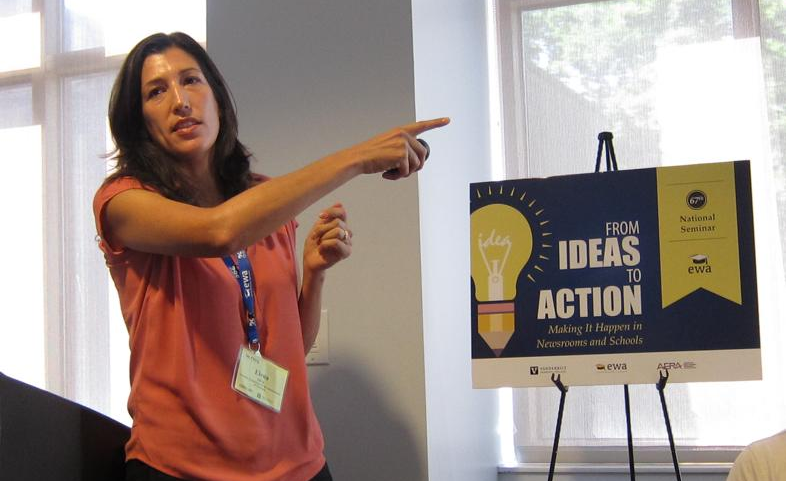
How Are Competency-Based Education and Student-Centered Learning Changing Schools?
More students are earning high school diplomas – but the diplomas don’t mean those students are ready to succeed in college.
Photo credit: EWA

More students are earning high school diplomas – but the diplomas don’t mean those students are ready to succeed in college.
Photo credit: EWA
More students are earning high school diplomas – but the diplomas don’t mean those students are ready to succeed in college.
Nicholas Donohue, president and CEO of the Nellie Mae Education Foundation, made that observation as he began to argue for a dramatic rethinking of the way schools measure learning, promote students and award diplomas. He made the argument during a “Deep Dive on Competency-Based Education and Student-Centered Learning” at EWA’s National Seminar in Nashville in May.
The U.S. high school graduation rate recently topped 80 percent, rising 10 percent in a decade, Donohue noted. But the rate of college readiness among those graduates has remained flat at 50 percent, he said.
At this rate, it will take another 174 years until all U.S. students finish high school ready for college, he estimated.
“Doing what we’re currently doing today, it’s looking pretty bleak,” he said.
The current American school system, in which all students are expected to move along at the same pace, regardless of how well they have learned a topic, “is becoming irrelevant and non-competitive” with other nations, Donohue argued.
Paraphrasing Sal Kahn of Kahn Academy, Donohue compared getting through high school to building a house, for which the builder gets only one week to complete each floor. Supposed it rains and you mess up the basement. Then you get a C plus and move on to build the first floor. After another week, you continue to the second floor – whether you’re ready or not. You end up with a house that won’t hold up.
Like the doomed house-building exercise, the current educational system keeps time constant, and the extent to which students build knowledge and skills becomes variable. Donohue called for a new way of doing things: Ensure all students master a skill before moving on, no matter how long it takes them. That means learning is constant, and time is variable. That’s the fundamental idea behind “competency-based” education, he explained.
Donohue’s foundation has been investing in school change experiments that focus on “student-centered learning.” Competency-based learning is just part of that equation, he said.
Student-centered learning has four tenets, he said:
A school with student-centered learning should run like an orchestra, Donohue said, in which each student masters a specialized set of skills according to his or her interests.
Elena Silva, a senior associate at the Carnegie Foundation for the Advancement of Teaching, gave a quick history lesson on how the U.S. education system became so tied to seat time. In 1906, Andrew Carnegie created the Carnegie Unit, now known as the credit hour, as a way to measure how much teachers were working. It was supposed to help differentiate high school from college, and determine professors’ pensions.
“It wasn’t supposed to be about learning,” she said. But the idea of the credit hour – a student spends a certain amount of time in class, and earns credit accordingly – “became the foundation for high school and college standards across the country.”
The practice of students shuttling through school, spending 50 minutes on math, 50 on science, and so on, and taking a standard four years to graduate, “has nothing to do with the way people learn,” Silva said.
Now the Carnegie Foundation is seeking to overhaul that system by supporting competency-based learning. The effort is gaining momentum, Silva noted: In April of 2013, the U.S. Department of Education opened up federal financial aid to the first college that offers competency-based diplomas with no relation to the credit hour.
And with the rise of dual enrollment and early college programs that allow high-school students to take college classes, the country is moving toward a more natural transition from high school to college, Silva said.
Rebecca Wolfe, director of Jobs for the Future’s Students at the Center project, offered the following tips for reporters covering this fast-expanding area and its accompanying jargon:
Laureen Avery, of UCLA’s Center X, shared some details of an effort her center is involved in to promote personalized learning in 13 high schools in Maine, Massachusetts, Vermont and New Hampshire. The project, the New England Network for Personalization and Performance (NENPP), is currently in year four of a five-year, $5 million federal investing in innovation (i3) grant.
Schools in the network are developing “personalized learning environments” in which students are tested on their mastery of certain skills. The method has already been tested in a consortium of 33 schools in New York state, where it has boosted graduation rates even among city kids with high rates of poverty and special needs, according to NENPP. Avery urged reporters to ask these questions of similar programs they come across:
Your post will be on the website shortly.
We will get back to you shortly